Fahlman B.D. Materials Chemistry
Подождите немного. Документ загружается.

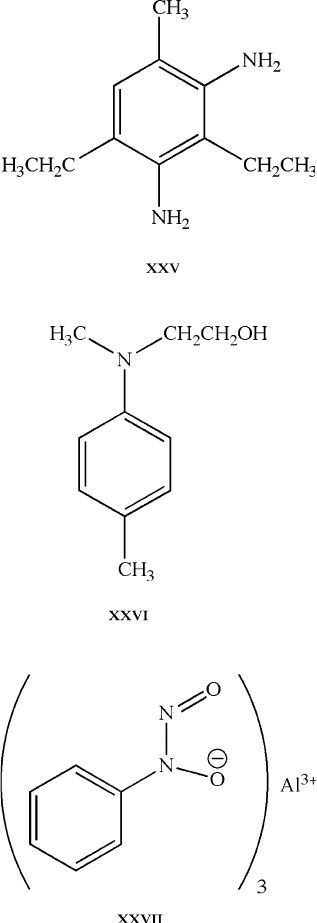
438 5 Polymeric Materials
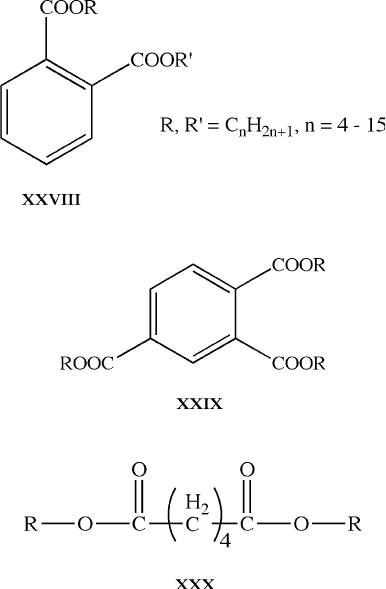
(iv) Plasticizers
[116]
or anti-plasticizers
[117]
(e.g., phthalates – XXVIII;
[118]
trimel-
litates – XXIX;
[119]
adipates – XXX
[120]
). Used to control the flexibility/
rigidity of the polymer.
(v) Coloring agents (e.g., inorganic pigments, organic dyes). Used to impart the
desired color(s) to the polym er.
(vi) Flame retardants (described later).
As their name implies, plasticizers are additives that soften a material, enhancing
its flexibility. The worldwide market for plasticizers is currently over five million
metric tons, with over 90% used to soften PVC. The most common plasticizers are
phthalates; however, due to the relatively high vapor pressure of these compounds,
plasticizers will evaporate from the polymer structure as evidenced by the “new car
smell” of new cars, as well as the organic film that becomes deposited on the interior
windshield surface. For these applications, it is best to use a plasticizer with a lower
volatility such as trimellitates.
There are two leading theories concerning the mechanism of activity for plasti-
cizer molecules. The ‘lubricating theory’ suggests that as the polymer is heated, the
plasticizer diffuses into the polymer and disrupts the van der Waal interactions
5.4. Polymer Additives 439
among polymer chains. Since network formation is reduced, the T
g
is lowered
resulting in more flexibility/softness of the bulk polymer. By contrast, the ‘free
volume theory’ suggests that the lowering of T
g
is due to the polymer chains being
pushed further apart by the interdiffusion of the plasticizer molecules. Since the free
volume of the polymer has been increased, the chains are free to move past one
another more easily resulting in greater flexibility.
The above mechanistic explanations assume that the plasticizer molecules are
not permanently bound to the polymer chains. Since these interactions are rela-
tively weak, there is likely a dynamic adsorption/desorption at various locations
among neighboring polymer chains. Accordingly, the plasticizer structure may
be fine-tuned to affect its solubility/miscibility with the polymer, as well as its
interactions with polymer chains and with other plasticizer molecules. As the
polymer–plasticizer interactions are strengthened, the T
g
will increase; at low con-
centrations, the rigidity of the polymer is increased due to effective rig id-network
formation between the plas ticizer and polymer. However, as the plasticizer concen-
tration is increased, the additive molecules themselves interact yielding the desired
softening characteristics. As illustrated by XXVIII above, the molecular structure
of a plasticizer contains both polar and nonpolar (hydrocarbon chain) units. It is
usually the polar endgroups that bind reversibly with the polymer chains; the length-
tunable nonpolar component affords controlled separation of neighboring polymer
chains.
5.4.1. Flame Retardants
Since polymers exhibit a hydrocarbon-based structure, these materials pose a sig-
nificant flammability threat. However, if one examines a room following a fire,
it is obvious that some polymers withstand ignition much greater than others
(Figure 5.75). In fact, these polymers are not naturally fire resistant, but rather
contain additives that afford this desirable property. The largest class of flame
inhibiting additives is brominated flame-retardants (BFRs). It is estimated that
bromine-containing molecules are added to over 2.5 million tons of polymers each
year, with the electronics industry accounting for the greatest consumer market.
BFRs are also used in a number of other produc ts such as electronic equipment
housing, carpets, paints/stains, fabrics, and kitchen countertops/appliances. Even the
“silly string” that our children plays with contains a brominated flame retardant
(hexabromobenzene) to prevent the dried-up string of poly(isobutylmethacrylate)
from catching fire.
Due to increasingly stringent environmental regulations, the use of BFRs is being
dramatically reduced – especially in Europe. The most widely used alternat ive is
organophosphorus-based (OP) flame-retardants (e.g., XXXI), which are much more
expensive than organohalogen additives. However, these molecules also contribute
to environm ental hazards, being found in air samples as far away as Antarctica and
in rainwater collected across European countries. Part of the problem stems from the
440 5 Polymeric Materials
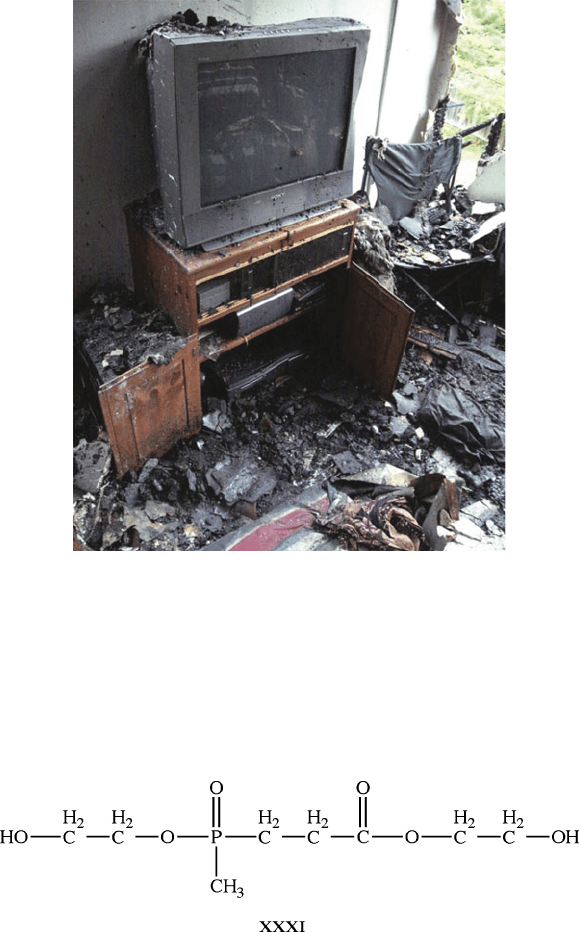
fact that OP flame retardants are not as active as BFRs, and must be present in much
higher concentrations to be effective – often at the expense of altering the physical
properties of the polymer.
Not unlike plasticizers, the most common method used to impart flame retardancy
is by simple mixing of the additives with the polymer during final processing.
However, a growing area of development is the design of functionalized monomers
that contain flame retardant groups (e.g., halogens, organophosphorus, Figure 5.76).
Figure 5.75. Photograph of damage from a candle-ignited fire that destroyed a campus fraternity house in
Amherst, MA. Flame r etardants likely prevented the television and surface-treated wood cabinet from
igniting. Reproduced from http://www.buildinggreen.com.
5.4. Polymer Additives 441
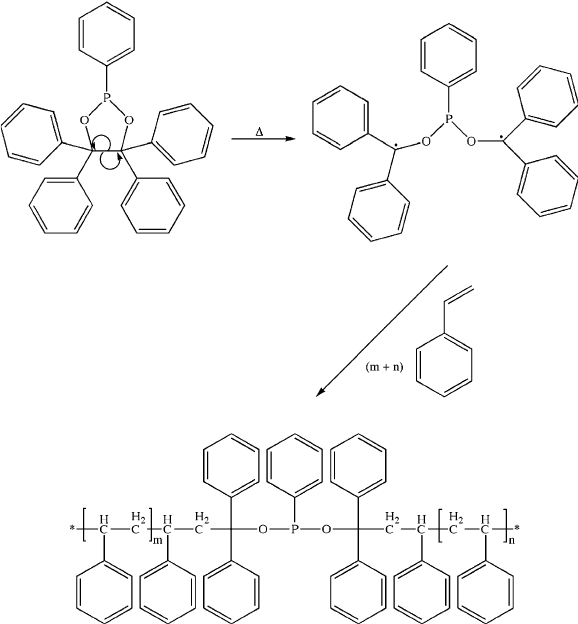
These monomers are known as reactive flame retardants, and yield a polymer that
has an inherent flame retardant characteristic – much more controllable than addi-
tives that are placed randomly within the polymer. However, this approach is not
widely used due to its relatively high production cost. Further, the inclusion of
functionalized monomeric units within the polymer chains may alter the physical
properties of the bulk polymer .
There are two primary reactive modes for flame-retardants: either gas-phase or
solid-state. Since a flame consists of a variety of gas-phase radicals and atoms
(Eqs. 11 and 12), a gas-phase flame retardant is one that will scavenge the flame-
propagating radicals such as
•
OH and O
•
. In particular, if the hydroxyl radical is
suppressed, the exothermic formation of CO
2
(Eq. 13) will be prevented thereby
reducing the flame temperature.
Figure 5.76. Example of the reactive flame retardant approach through incorporation of an
organophosphorus unit in the polymer main chain.
[121]
442 5 Polymeric Materials
H
þO
2
,
OH + O
ð11Þ
O
þH
2
,
OH + H
ð12Þ
OH + CO , CO
2
+Hð13Þ
Halogenated flame-retardants are active in the gas-phase by combining with
radicals. The organohalogen compound (MX) first thermally decomposes to form
halogen radicals that combine with hydrogen radicals or fuel to form hydrogen
halide (HX) (Eqs. 14–15). It should be noted that BFRs all possess aromatic
structures since the flame temperature is sufficient to break aromatic C—Br bonds
(C—Cl require higher temperatures). By comparison, aliphat ic C—Br bonds are
broken at temperatures lower than the flame, resulting in pre-decomposition of
the organobromine compound and neglige nt flame retardancy. Often, antimony
oxide (Sb
2
O
3
) is used in combination with BFRs since the side-product of SbBr
3
is sufficiently volatile, and carries a high concentration of bromine into the
gas-phase.
MX , M
þX
ð14Þ
X
þH
, HXð15Þ
The thermally-generated HX species may also behave as flame inhibitors by
scavenging hydrogen, hydroxyl and oxygen radicals (Eqs. 16 and 17 ):
H+HX , H
2
þX
ð16Þ
OH + HX , H
2
O+X
ð17Þ
By contrast, solid-state flame-retardants such as organophosphorus agents act by
passivating the surface of the polymer toward heat, flame, and oxygen through
formation of a carbonaceous coating known as a char. When thermally decomposed,
some phosphorus compounds generate acids that promote surface crosslinking
reactions and resultant char formation. Quite often, phosphorus flame-retardants also
have gas-phase reactivity, whereby PO
•
radicals help to scavenge flame-propagating
species in the flame. Though the mechanism is not currently known, the use of nitrogen
compounds (or N-containing polymers such as poly(amide)s) enhances char formation.
This is most likely due to a lower number of reactive C/H/O-containing units that
volatilize to fuel the flame.
Another interesting area of recent development is the synthesis of dual-action
flame-retardants that contain both organophosphorus and organobromine units
(Figure 5.77).
[122]
Since these agents are active in both gas- and condensed phases,
the activity is proposed to be much higher than current additives at much lower
concentrations – in accord with environmental regulations. In addition, the synthesis
of these agents is relatively inexpensive, which is also a stringent guideline in the
development of alternative additives for such a large market sector.
5.4. Polymer Additives 443

IMPORTANT MATERIALS APPLICATIONS IV:
SELF-HEALING POLYMERS
Imagine getting into an accident only to have your vehicle revert back to its original
shape before your eyes! Though this certainly sounds like something out of a science
fiction novel, these materials are fast becoming a reality. The general strategy for
this activit y is to have the healing agents as a part of the polymer, which become
activated upon crack formation. This was first demonstrated with microcapsules of a
urea-formaldehyde shell that contained a dicyclopentadiene monomer, suspended
within an epoxy polymer matrix. Of course, without a polymerization catalyst,
nothing would happen; hence, crystals of Grubbs’ catalyst were als o dispersed in
Figure 5.77. Molecular structures of dual-action brominated organophosphorus flame retardants. Shown
are (a) (4-bromophenyl)diethylphosphate, (b) (2,4-dibromophenyl)diethylphosphate, (c) (2,4,6-tribromo
phenyl)diethylphosphate, and (d) (2,3,4,5,6-pentabromophenyl)diethylphosphate.
444 5 Polymeric Materials
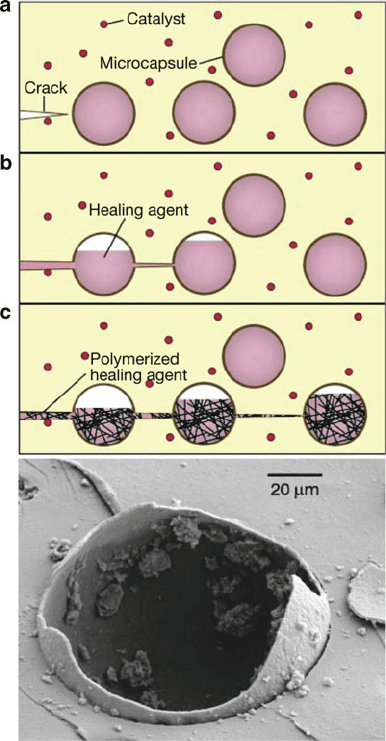
the polymer (Figure 5.78). The encapsulation of the Grubbs’ catalyst within a wax
microsphere has been reported to improve the dispersity in the epoxy matrix and
prevent side reactions between the catalyst and the amine-based epoxy curing
agents.
[123]
A technique referred to as ring-opening metathesis polymerization (ROMP)
[124]
using Grubbs’ catalyst (Figure 5.79) was chosen due to rapid polymerization under
Figure 5.78. Schematic illustrating the mode of action of self-healing polymers through embedded
healing-agent microcapsules that are activated by a propagating crack. Also shown is a polymeric
microcapsule following rupture. Reproduced with permission from White, S. R.; Sottos, N. R.;
Geubelle, P. H.; Moore, J. S.; Kessler, M. R.; Sriram, S. R.; Brown, E. N.; Viswanathan, S. Nature,
2001, 409, 794. Copyright 2001 Macmillan Magazines.
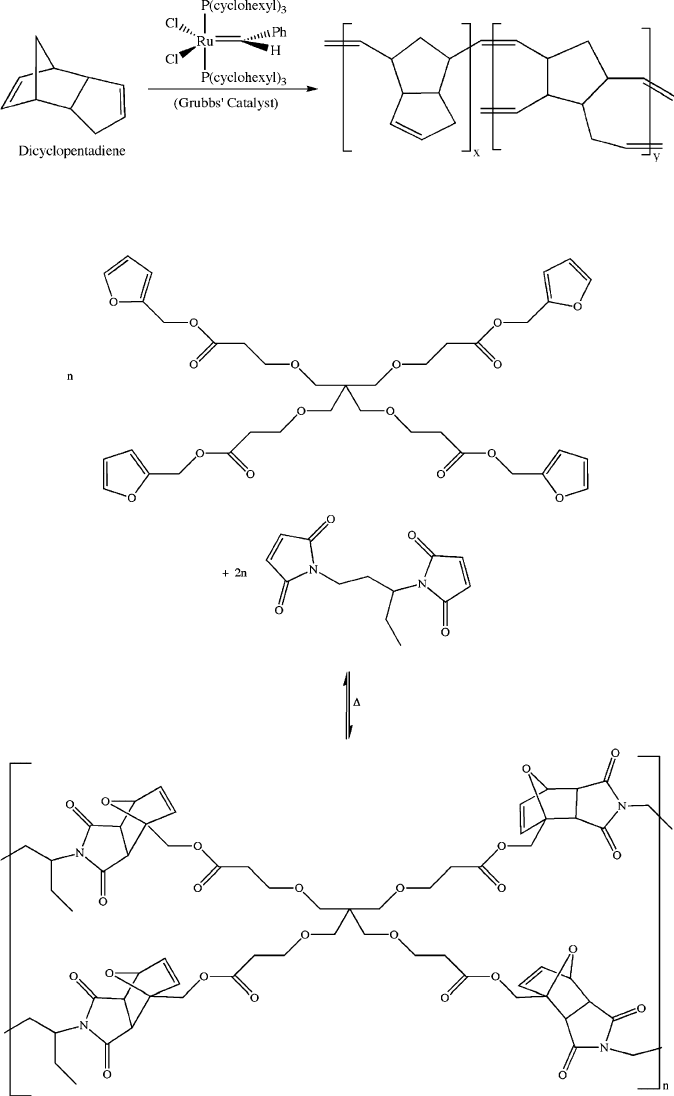
Figure 5.80. Thermally induced self-healing through a Diels-Alder reaction.
[127]
Figure 5.79. Ring-opening metathesis polymerization (ROMP) of dicyclopentadiene catalyzed by
Grubbs’ catalyst.
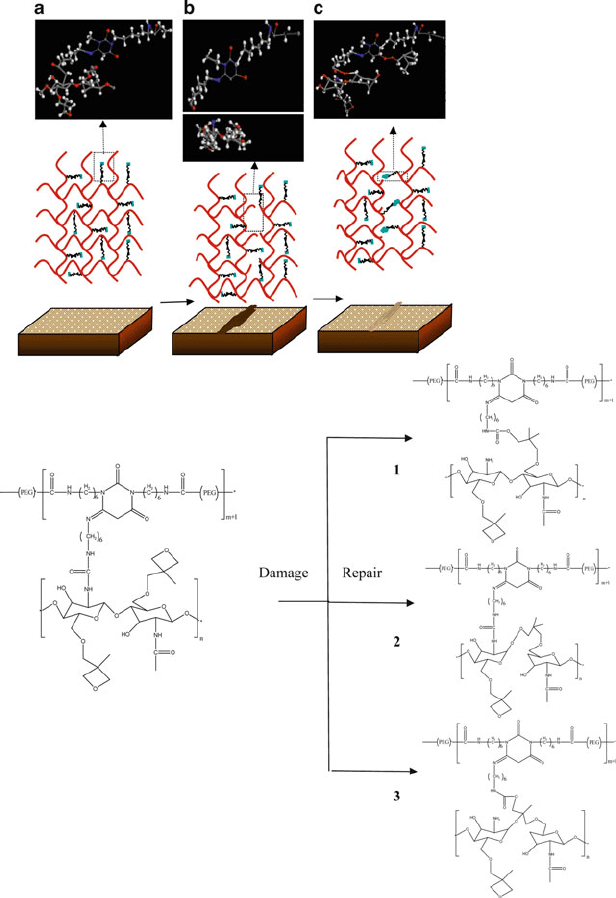
Figure 5.81. Top: proposed mechanism for the repair of oxetane-substitute chitosan polyurethane (OXE-
CHI-PUR) networks. The crosslinked network is represented by red thick lines, whereas dangling OXE
entities are black thinner lines. As mechanical damage is created (b), OXE rings open up. Upon exposure
to UV light, crosslinking reactions of the OXE-CHI entities result in self-healing of the damaged area,
(c). Bottom: illustration of chemical reactions leading to UV-induced polymer repair. Shown are (1) breaking
of urea linkages as well as the ring opening of OXE and formation of urethane linkages, (2) OXE ring
opening and scission of the CHI linkages and the formation of alkyl peroxide linkages, and (3) urea
breakage, CHI and OXE ring opening and formation of urethane and linear —C—O—C— crosslinks.
Reproduced with permission from Science 2009, 323, 1458. Copyright 2009 American Association for the
Advancement of Science.
5.4. Polymer Additives 447
